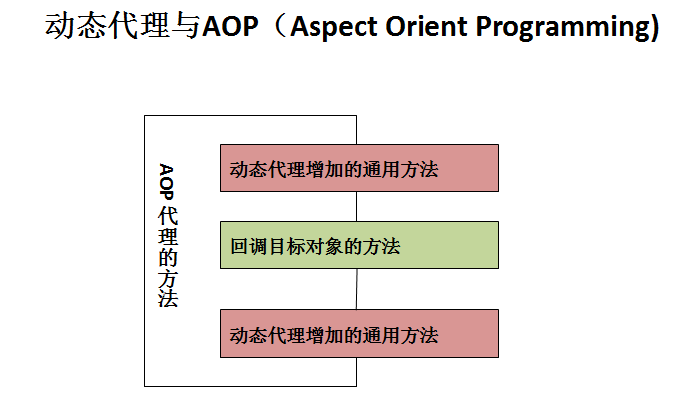静态代理示例代码:
/*
* 静态代理:只适合具体的代理
*/
interface ClothFactory {
void clothProduct();
}
class NikeFactory implements ClothFactory {
@Override
public void clothProduct() {
System.out.println("Product Nike Sports.");
}
}
class ProxyFactory implements ClothFactory {
ClothFactory cf;
//创建代理类对象时,实际传入一个被代理对象
public ProxyFactory(ClothFactory cf) {
this.cf = cf;
}
@Override
public void clothProduct() {
System.out.println("You need give $10000 to ProxyFactory");
cf.clothProduct();
}
}
public class TestClothProduct {
public static void main(String[] args) {
NikeFactory nf = new NikeFactory();//创建被代理对象
ProxyFactory pf = new ProxyFactory(nf);//创建代理对象
pf.clothProduct();
}
}动态代理示例代码:
/*
* 动态代理:可通用所有的代理
*/
import java.lang.reflect.InvocationHandler;
import java.lang.reflect.Method;
import java.lang.reflect.Proxy;
//动态代理的使用,体会反射是动态语言的关键
interface Subject {
void action();
}
//被代理类
class RealSubject implements Subject {
@Override
public void action() {
System.out.println("I am RealSubject!");
}
}
class MyInvocationHandler implements InvocationHandler {
Object obj;// 实现了接口的被代理类的对象的声明
// ①给被代理的对象实例化②返回一个代理类的对象
public Object blind(Object obj) {
this.obj = obj;
return Proxy.newProxyInstance(obj.getClass().getClassLoader(),
obj.getClass().getInterfaces(), this);
}
//当通过代理类的对象发起对被重写的方法的调用时,都会转换为对如下的invoke方法的调用
@Override
public Object invoke(Object proxy, Method method, Object[] args) throws Throwable {
Object returnVal = method.invoke(obj, args);//method方法的返回值时returnVal
return returnVal;
}
}
public class TestProxy {
public static void main(String[] args) {
//1.被代理类的对象
RealSubject real = new RealSubject();
//2.创建一个实现了InvacationHandler接口的类的对象
MyInvocationHandler handle = new MyInvocationHandler();
//3.调用blind()方法,动态的返回一个同样实现了real所在类实现的接口Subject的代理类的对象。
Object obj = handle.blind(real);
Subject subject = (Subject)obj;
subject.action();
//再举一例
NikeFactory nf = new NikeFactory();
ClothFactory cf = (ClothFactory) handle.blind(nf);//proxyCloth即为代理类的对象
cf.clothProduct();
}
}AOP示例图:
AOP示例代码:
import java.lang.reflect.InvocationHandler;
import java.lang.reflect.Method;
import java.lang.reflect.Proxy;
interface Human {
void info();
void fly();
}
//被代理类
class SuperMan implements Human {
@Override
public void info() {
System.out.println("Call me SuperMan!");
}
@Override
public void fly() {
System.out.println("I can fly!");
}
}
class HumanUtil {
void method1() {
System.out.println("==========方法一==========");
}
void method2() {
System.out.println("==========方法二==========");
}
}
class MyInvocationHandler2 implements InvocationHandler {
Object obj;// 被代理类对象的声明
public void setObject(Object obj) {
this.obj = obj;
}
@Override
public Object invoke(Object proxy, Method method, Object[] args) throws Throwable {
HumanUtil h = new HumanUtil();
h.method1();
Object returnVal = method.invoke(obj, args);
h.method2();
return returnVal;
}
}
class MyProxy {
// 动态的创建一个代理类的对象
public static Object getProxyInstance(Object obj) {
MyInvocationHandler2 m = new MyInvocationHandler2();
m.setObject(obj);
return Proxy.newProxyInstance(obj.getClass().getClassLoader(),
obj.getClass().getInterfaces(), m);
}
}
public class TestAOP {
public static void main(String[] args) {
SuperMan superMan = new SuperMan();//创建一个被代理类的对象
Object obj = MyProxy.getProxyInstance(superMan);//返回一个代理类的对象
Human human = (Human) obj;
human.info();//通过代理类的对象调用重写的抽象方法
System.out.println();
human.fly();
System.out.println();
//*********
NikeFactory nf = new NikeFactory();
Object obj2 = MyProxy.getProxyInstance(nf);
ClothFactory cf = (ClothFactory) obj2;
cf.clothProduct();
}
}